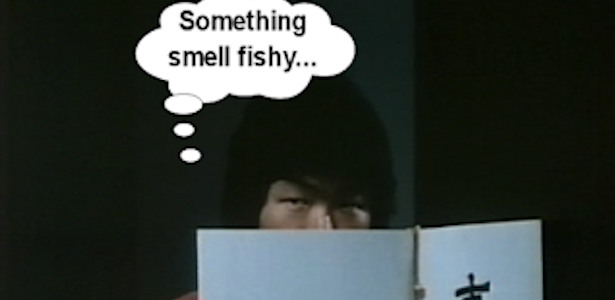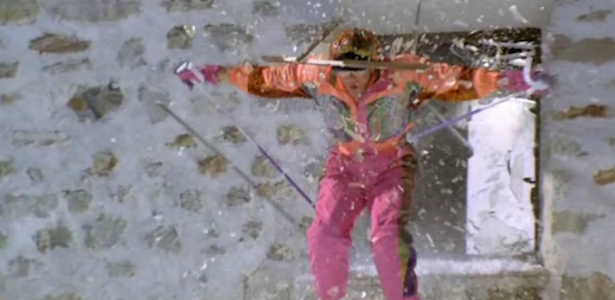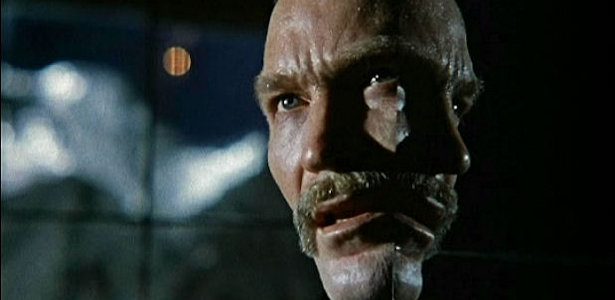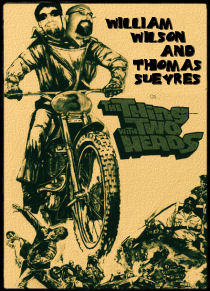The movie history headlines this past week or so have been filled up with bad news. Specifically, the classic comedy THE BAD NEWS BEARS (1976) celebrating its fortieth anniversary. Amazingly, the same day that hit theaters (April 7, 1976) another film also came out in limited release that would create its own lasting impact on Hollywood. Yes, today also marks the anniversary of the release of the car chase classic EAT MY DUST (1976).
Roger Corman’s New World Pictures was behind EAT MY DUST and it isn’t very difficult to figure out why this one got made. The previous year Corman’s company had seen its biggest theatrical success with the release of Paul Bartel’s DEATH RACE 2000 (1975), which expertly combined sci-fi, social commentary and dark humor. My own personal theory is Corman sat down and thought, “Damn, I loved making money but I had to spend more on that film than usual due to the futuristic cars and costumes. How can I make that cheaper?” Easy: Just do a car chase flick set in modern times. We would be remiss if we didn’t also mention that H.B. Halicki’s GONE IN 60 SECONDS (1974) was also leaving the competition in the dust at the box office at the time, so a contemporary flick around gearheads was a no brainer. The writing and directing chores fell to old Corman stalwart Charles B. Griffith and he made sure to feature enough vehicular mayhem to satiate audiences.
Perhaps Corman and Griffith’s biggest coup was in casting Ron Howard as lead Hoover Niebold. An actor practically since birth, Howard had already been in the hot rod classic AMERICAN GRAFFITI (1973) and had just started in the television sitcom HAPPY DAYS; despite being in his early 20s, Howard was having a hard time transitioning to adult roles in the eyes of many Hollywood folks (he was routinely referred to as “Ronnie Howard” in the trade papers). In fact, his most recent leading role prior to this film was playing Huckleberry Finn in the TV movie HUCKLEBERRY FINN that debuted on ABC on March 25, 1975. That year was good for Howard as the incredibly successful HAPPY DAYS got renewed and he got married in June 1975. The 21-year-old, however, would get the opportunity of a lifetime with the lead in EAT MY DUST later in the year (more on that in a bit).
At one point simply titled THE CAR (according to a piece in Variety New World found out via testing this “wasn’t an effective title”), DUST ended up doing a quick shoot (as per Corman’s blueprint) and roared into theaters in April 1976. Described by Variety as a “money-making car chase comedy for [the] youth market” in their review, DUST started bringing in the cash as soon as the flags dropped. In May 1976 the company announced that DUST had become their all-time biggest domestic grosser “exceeding the $2,500,000 generated last summer on DEATH RACE 2000.” In June Corman ushered out 500 prints of the film to theaters and in July offered a double feature package with DEATH RACE 2000, the film it usurped. Around the same time, Corman quickly announced a follow up initially titled FOLLOW THE SPEEDER. And here is where Howard took a gamble that would pay off for him in a big way. He convinced Corman that he would star in the picture if Howard could also direct it. Known for giving neophytes their first break (and probably loving a cost-saving actor-writer-director combo), Corman agreed and Howard found himself in the director’s seat in March 1977 on what was now called GRAND THEFT AUTO. Again with a whiplash turnaround, AUTO made it to theaters in June 1977 and repeated the success of DUST. The rest, as they say, is history. Howard continued on HAPPY DAYS, but now had a theatrical hit as a director under his belt. After directing some TV movies, he effortlessly made the switch to full-time director in the 1980s and grew to be one of the biggest (and most diverse) directors of that generation. And mostly because he decided to let someone eat his dust.
Roger Corman’s New World Pictures was behind EAT MY DUST and it isn’t very difficult to figure out why this one got made. The previous year Corman’s company had seen its biggest theatrical success with the release of Paul Bartel’s DEATH RACE 2000 (1975), which expertly combined sci-fi, social commentary and dark humor. My own personal theory is Corman sat down and thought, “Damn, I loved making money but I had to spend more on that film than usual due to the futuristic cars and costumes. How can I make that cheaper?” Easy: Just do a car chase flick set in modern times. We would be remiss if we didn’t also mention that H.B. Halicki’s GONE IN 60 SECONDS (1974) was also leaving the competition in the dust at the box office at the time, so a contemporary flick around gearheads was a no brainer. The writing and directing chores fell to old Corman stalwart Charles B. Griffith and he made sure to feature enough vehicular mayhem to satiate audiences.
Perhaps Corman and Griffith’s biggest coup was in casting Ron Howard as lead Hoover Niebold. An actor practically since birth, Howard had already been in the hot rod classic AMERICAN GRAFFITI (1973) and had just started in the television sitcom HAPPY DAYS; despite being in his early 20s, Howard was having a hard time transitioning to adult roles in the eyes of many Hollywood folks (he was routinely referred to as “Ronnie Howard” in the trade papers). In fact, his most recent leading role prior to this film was playing Huckleberry Finn in the TV movie HUCKLEBERRY FINN that debuted on ABC on March 25, 1975. That year was good for Howard as the incredibly successful HAPPY DAYS got renewed and he got married in June 1975. The 21-year-old, however, would get the opportunity of a lifetime with the lead in EAT MY DUST later in the year (more on that in a bit).
At one point simply titled THE CAR (according to a piece in Variety New World found out via testing this “wasn’t an effective title”), DUST ended up doing a quick shoot (as per Corman’s blueprint) and roared into theaters in April 1976. Described by Variety as a “money-making car chase comedy for [the] youth market” in their review, DUST started bringing in the cash as soon as the flags dropped. In May 1976 the company announced that DUST had become their all-time biggest domestic grosser “exceeding the $2,500,000 generated last summer on DEATH RACE 2000.” In June Corman ushered out 500 prints of the film to theaters and in July offered a double feature package with DEATH RACE 2000, the film it usurped. Around the same time, Corman quickly announced a follow up initially titled FOLLOW THE SPEEDER. And here is where Howard took a gamble that would pay off for him in a big way. He convinced Corman that he would star in the picture if Howard could also direct it. Known for giving neophytes their first break (and probably loving a cost-saving actor-writer-director combo), Corman agreed and Howard found himself in the director’s seat in March 1977 on what was now called GRAND THEFT AUTO. Again with a whiplash turnaround, AUTO made it to theaters in June 1977 and repeated the success of DUST. The rest, as they say, is history. Howard continued on HAPPY DAYS, but now had a theatrical hit as a director under his belt. After directing some TV movies, he effortlessly made the switch to full-time director in the 1980s and grew to be one of the biggest (and most diverse) directors of that generation. And mostly because he decided to let someone eat his dust.









































































